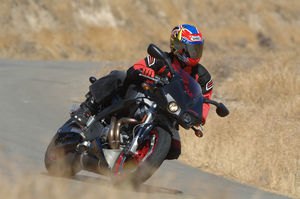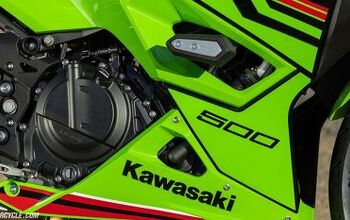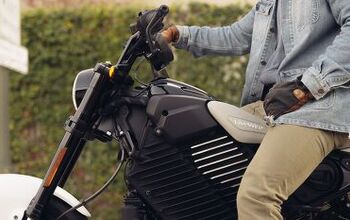Firebolts, Lightnings and an XB-RR: Buells in Bakersfield - Motorcycle.com
Adding to my list of horrible geographic locations-you might recall I have dissed Phoenix and Alabama-is Bakersfield, CA. It is dusty, hot, polluted and in general a pretty grim place.
However, it does have the saving grace of being in between Buttonwillow Raceway Park, a sweet, three-mile sports car track 150 miles from LA, and highway 155, a twisty, beautifully-paved road that carries a motorcycle and rider from the grimy, overheated cesspool below to the cooler, cleaner mountains that rise above the California Central Valley.
So I won't fault Buell American Motorcycles too much for choosing Bakersfield as the site of their 2007 Model Lineup press launch.
Let's get this out of the way, to weed out readers who just want to know what's new with Buell this year; new tires. That's about it. Buell is ending their long relationship with Dunlop and has a new bride, sexy Italian tire maker Pirelli. Is this change important enough to write an entire feature article about? Maybe not. However, to spice things up, Buell brought a pair of their XB-RR racebikes and allowed the motley collection of journalists ride them at Buttonwillow. There are a couple of other changes to the Ulysses as well. Interested? After a complimentary hotel breakfast during which I suffered the indignities of consuming smoked salmon without bagels or even a trace of cream cheese, we gathered in a conference room for a tech briefing, which was probably remarkably similar to the prior year's tech briefing.
Said briefing contained much interesting and pertinent information about what makes a Buell a Buell and why that is good. A room full of journalists gave out a slightly-disappointed "hmm" when company founder Erik Buell told us that 2007 is "a year of refinement." However, the only thing that is really changing is the brand of tires, the seat on the Ulysses, and some bold new graphics.Pirelli's people were up next to tell us about the tires on the Buells. Most of the product line will receive special version of the mass-market Pirelli Diablo tire. Designed for aggressive street riding and track days, the Diablo uses Pirelli's patented 0-degree steel belt and rayon carcass.
This gives the tire a lighter, more neutral feel, keeping the contact patch a consistent size for more neutral, confident handling. Icing on the big rubber cake is that the Buells will use "T"-spec Diablos, which use less rubber and a lighter bead to reduce weight and rotational mass. The front is 10 ounces lighter than a standard Diablo, and the rear weighs in at a more than a pound less.
"A more aggressive, enduro-like tread pattern for better wet and dirt performance." The Ulysses and City X will now both get the Scorpion Synch, a tire designed for Supermoto use in Europe. It has a more aggressive, enduro-like tread pattern for better wet and dirt performance. We loved these tires on the City X last year, and there is no reason to believe they won't work well on the Ulysses, too. Of all the models, the Ulysses gets the most re-vamping. Buell's product planners and engineers listened to feedback from customers, internet chatrooms (they'll learn) and even from half-witted magazine editors to make a few changes. For 2007, the Ulysses gets a re-designed seat that is not only lower and narrower at the front, but also uses "pressure mapping"--where a piece of pressure-sensitive material is placed under many different asses--to develop a truly comfortable touring seat. A gel seat is now offered for extra comfort, and for NBA centers, the original 2006 seat as well.
In addition to the new seat, the Ulysses gets a new triple-rate fork spring to firm up the front end. There's also some new accessories, like a Buell-branded Garmin GPS system, a higher windscreen, hard luggage (a top case and side cases), and camouflage bodywork for some triple-digit duck hunting.
The rest of the line up gets new colors, like Cherry Bomb Red Translucid and Midnight black. There are new colors for the wheels and Thunderbolt windscreens, and the "tank" graphics are new as well. That "tank" is actually the airbox lid, and it has been re-vamped across the line as well. Enough about spec sheets; it is time to ride the bikes. It's already up to 88 degrees at 10 in the morning as we leave the air-conditioned womb of our hotel and walk over to the 2007 Buells. The new translucid colors and giant Buell emblems look great in the bright sunlight, and I pick a Ulysses to start the day on; there's going to be some straight-line droning before we get on the two-lane twisty road to Lake Isabella, and I want to test the new seat.
The bike is still absurdly tall for 5'6" editors, but not as bad as last year. I can get one foot down, anyway, and the bike is so easy to ride I'm out on the road with little difficulty, sliding the back tire and popping teeny wheelies as I follow the rest of the pack to the freeway. Out on the road, the Buell displays the same smooth ride, good handling manners and great comfort we reported in our 2005 Sport Touring test. The long-travel suspension takes some getting used to, although the new triple-rate springs minimize the see-saw effect bikes with long-travel suspension tend to have during aggressive riding. The motor is perfect for fast, flowing roads, and it feels like it would be plenty strong even two-up with luggage.
I have a brief opportunity to ride the big orange bike on a winding dirt road up to a photo location, and I follow photographer Tom Riles as he performs Unnatural Acts with his hapless rental car (never, ever buy a rental car, as Tom really gets around). In the dirt, the Ulysses feels heavy and large for a small, novice dirt biker, but still has surprising grip and nimbleness. Cruising up the hill, I am alarmed when the bike jumps over a couple of hidden bumps, but relieved when it comes down in one solid piece, without the chassis becoming upset. In deeper dirt I notice the same unsteady feel the Triumph Tiger shares, but I think this can be overcome by not being me and riding faster. However, more expert dirt riders will want cleated footpegs, to help keep their feet on the pegs, and slightly higher bars for when they are standing on those grippier pegs. The tires, although offering more grip than tires like this reasonably should in the dirt, are still a far cry from knobbies. However, the Ulysses is not really intended as a dirt bike; rather, it is for gently exploring dirt roads so Buell-mounted tourists aren't restricted from the 35 percent of US roads that are still, even in this day and age, unpaved, according to Buell.
I've had limited experience on Buells up to now, having only evaluated the XB9SX city cross in our in our Value Middleweights comparison test and the Ulysses in the Sport Touring comparo last year. So naturally, I was wondering, like many of you might be wondering, which Buell is best? Is the tucked-in seating position of the Firebolt series better for hustling the bike through a series of turns? Will the torque of the 1200cc motor overcome the extra 700 RPM the smaller 985 motor offers?
I can answer one question definitely; the Supermoto-esque seating position on the Lightnings is the way to go for street riding. Your head is up to see through the curves, your back is comfortable, and most importantly, the footpegs feel much more rational than the high and forward pegs on the Firebolts. On the street, ground clearance shouldn't be an issue (and the peg feelers come off it is for you, although I think you need therapy more than ground clearance if that is the case) and the legroom means you can ride much further and longer than a Firebolt-mounted rider can.
On the street, the bigger motor makes more sense for the majority of riders, although those used to Japanese fours (and Italian twins) might prefer the fizzier revving of the XB9. It gives you a bit of over-rev that keeps you from shifting too much if you are really going for it. The City X is just as much fun as I remembered, with nimble handling and a comfortable seat with more leg room. But that big 1200 motor is great, with a deep, rumbling vibration that is never intrusive, thanks to Buell's Uniplanar mounting system, and heaps, waves, mounds of torque available at around 3,000 RPM. On both motors, power is good but not great; the last XB9 we tested made 72 HP at the back wheel and the last XB12 made 87. It's enough to get sent to jail and enough to have more than a good time.
The bikes are far from perfect, even if you don't mind double-digit horsepower. Fuel injection is good enough for me but not as perfect as you would expect from other factories. I heard popping and pinging from the exhaust and cylinder head, and power delivery is kind of flat and slow, even if redline is reached all-too-soon. The gearboxes are still clunky, requiring plenty of clutch and smooth throttle to counteract the imperfect fuel injection and abrupt engine braking. Hey, you want torque, you got torque. Having a flounder-flat torque "curve" has its price. However, the XB's chassis and brakes make for a solid platform to enjoy the ride from, just like last year and the year before that. What is new--Pirelli tires across the line-up-- adds to the whole experience.
One thing that made all of us at MO take notice of the City X was the Pirelli tires, and they complement the other models just as well. They are light, turn progressively and evenly, and grip well too, giving you lots of confidence in sandy, greasy or gravel-strewn corners. That lightness is at the expense of tire life, but I don't think replacing the lighter "T" spec tires with standard issue Diablos will damp your fun too much. The mix of bikes made for one of the most satisfying days of riding I've had for a while. This could be because highway 155 is beautiful: winding, well-paved and almost free of cars on a weekday.
"Buells have always had an unmistakable feel to them that reflects their designer's desire to make motorcycles that are fun and satisfying to ride on any kind of road." Buells have always had an unmistakable feel to them that reflects their designer's desire to make motorcycles that are fun and satisfying to ride on any kind of road, and Harley's cash infusion has polished the rough edges enough so you're not worried about straying too far from home or agonized by uncomfortable ergonomics. There may be better sportbikes for the street, but I always think of Buells first. A 200-mile day of riding comes to a close. We go to bed after more meat, Scotch and a trip to the go-kart track courtesy of Harley-Davidson. The next morning we arisehome his Gospel. It's all stuff we've heard before, although I find a few items interesting.
bright and early to shovel down some more rubbery scrambled eggs and bagel-less lox to attend yet another tech briefing before the track day. The Man himself gives the talk, to further pound
First, a Buell sportbike has about half the parts of a Japanese 600cc or liter machine. This allows Buell to make and purchase higher-quality components while still keeping the price reasonable. Also, fewer parts means they can use more precision machining, meaning less slop and a tighter feel, even on older bikes.
Belt drive is also a cool thing more manufacturers should jump on, in my opinion. Belts offer less unsprung mass, cleaner, quieter operation, and eliminate maintenance. I have severe chain-a-phobia; I loathe cleaning and lubing chains, and I am hopeless at aligning axles. Sure, tell me all about your string and laser pointers or shaman rituals you claim are so easy to do to align your chain, but when Erik tells me about a system that goes 100,000 miles without wearing out or being adjusted, I am sold.
A belt also loses the same amount of power to friction as a clean, new chain, but is more efficient than a dirty, misadjusted one. And how many of you out there right now have perfectly clean, adjusted and lubricated chains? Not me. To top it all off, Erik said a belt is "a quarter the weight of a chain". All of these benefits are "better for the customer", so even if it costs a lot more money (which eats into what must be an already slim profit margin for a small-volume manufacturer) it's still "the right thing to do."
The physics of Erik's Zero Torsional Load (ZTL) system of his lightweight wheels and brakes bear mentioning as well. The front wheel, tire and rotor of a 2007 Ulysses are a full 10 pounds lighter than the front hoop assembly on a BMW R1200GS. This translates to all kinds of advantages with names like "turn inertia" and "spin inertia" with complex formulae that make me dizzy to look at. Still, you don't need to be Stephen Hawking to understand the advantages of less unsprung mass. Finally, where is it written that the gas tank has to be up here and the exhaust pipe has to be out there?
As far as I can tell, gas tanks are behind the steering stem above the motor because that's where it made sense to put them on the first motorcycles, which were bicycles with motors clipped to them. However, technology and time marches on, and Erik thinks "it's stupid to have the tank up here". It raises the bike's center of gravity and takes away valuable airbox space (some of you may remember the awful breadbox-sized thing sticking off the side of older Buell models). Why not put the gas in the frame? And the oil in the swingarm? And while we're at it, tuck that exhaust way under the bike.
Placing it up high under the seat or sticking out to one side looks cool, but it does detract from handling. And to vindicate Mr. Buell, observe how other manufacturers-like Yamaha and Suzuki-have followed suit in recent years.
Buell XB-RR
A squeaking chorus of glee arose from the assembled journalists when we were told we would get to ride the factory-prepped XB-RR racebike. The announcement was even enough to mask our disappointment to find that the only big change for the rest of the line was new tires. Designed for Formula Extreme competition, it's basically a much-enhanced XB12R designed for use by privateers. The engine is a modified XB12 Thunderstorm motor. The stock bore of 88.9 mm is hogged out to 103.6, and stroke is decreased to 79.4 mm to create a higher-revving motor displacing 1,339 cc, near the class limit of 1350 cc. Compression goes to 12.5:1 from the stock 10:1, fed by bigger (than my freakin' head!) 62mm throttle bodies. Air and small birds are funneled into the giant airbox through a ram-air system. This is good for 150 HP measured at the crank, and tuners can use the included Windows-based fuel injection programming software to make the motor run perfectly or order Cialis from Canadian pharmacies.
Chassis changes are similarly straight forward. The stock XB chassis is modified simply by welding Ulysses sideplates onto the frame (to increase fuel capacity to 4.4 gallons) and the addition of a new swingarm with billet axle adjustment plates for the chain final drive conversion. Suspension is by Ohlins; a 43mm fork in front and a linkage-less shock in the rear. There is still only one perimeter-mounted brake disc on the all-magnesium wheel, but it uses an eight-piston caliper with four pads. Grab-ola!
"The entire package is wrapped up in wind-tunnel designed bodywork reminiscent of the old Harley-Davidson roadracers from the early 70's."
It weighs in at 362 pounds (the minimum allowable weight is 350), about 30 less than the stock bike. About 50 will be built this season for pre-approved racers, mostly Buell and Harley-Davidson dealerships with existing racing teams. Pricing will be $30,995.
Production was delayed by some glitches early in the season that have been corrected. The main issue was a "weak gear pitch", which caused a failure at Daytona. This problem has been corrected by using an off-the-shelf gearset, although it delayed production. Also, moving the timing rotor to the other side of the crank created a "resonant wave", according to Erik, that caused other problems. With a few other little fixes, Erik has declared the XB-RR ready for battle; will it be strong enough to make an impact on the world of club and national road racing?
More by Gabe Ets-Hokin






































Comments
Join the conversation